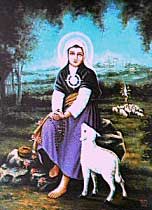|
Pibrac |
||||||||
| St. Germaine Cousin1579-1601 | ||||||||
|
Her younger siblings and her stepmother abused her, scalding her with boiling water, starving her, and forcing her to sleep in the stable. Germaine was left to tend her family's flock of sheep and rarely experienced human companionship.
Forty years later her unmarked grave was accidentally opened by workmen. Her body was perfectly preserved, with a garland of carnations and rye in her hair. Two elderly villagers identified the body by the withered hand and scars on the face. Shortly after, her body was displayed in the church, and miraculous healings occurred among the pilgrims who came to see her. During the French Revolution, her grave was desecrated. Quicklime and water sizzled away her flesh. Her bones are now inside a wax mannequin which lies in a glass and bronze reliquary in the parish church at Pibrac, France. |
|
|

|
|||||
|
|
||||||||
|
|
|
Saint Germaine Cousin is the patron saint of abuse victims, peasant girls, and physically challenged people . Her feast day is June 15. |
|
|||||
|
|
||||||||
